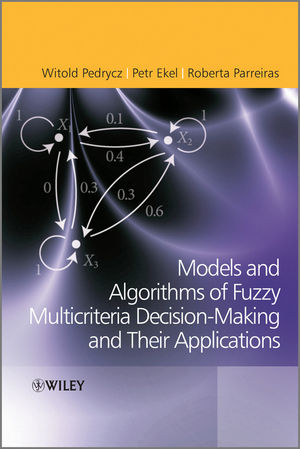Fuzzy Multicriteria Decision-Making: Models, Methods and ApplicationsISBN: 978-0-470-68225-8
Hardcover
360 pages
December 2010
 |
||||||
Foreword.
Preface.
1 Decision-Making in System Project, Planning, Operation, and Control: Motivation, Objectives, and Basic Concepts.
1.1 Decision-Making and its Support.
1.2 Optimization and Decision-Making Problems.
1.3 Multicriteria Decision-Making.
1.4 Group Decision-Making.
1.5 Fuzzy Sets and their Role in Decision-Making Processes.
1.6 Conclusions.
References.
2 Notions and Concepts of Fuzzy Sets: An Introduction.
2.1 Sets and Fuzzy Sets: A Fundamental Departure from the Principle of Dichotomy.
2.2 Interpretation of Fuzzy Sets.
2.3 Membership Functions and Classes of Fuzzy Sets.
2.4 Fuzzy Numbers and Intervals.
2.5 Linguistic Variables.
2.6 A Generic Characterization of Fuzzy Sets: Some Fundamental Descriptors.
2.7 Geometric Interpretation of Sets and Fuzzy Sets.
2.8 Fuzzy Sets and the Family of α-cuts.
2.9 Operations on Fuzzy Sets.
2.11 Conclusions.
References.
3 Selected Design and Processing Aspects of Fuzzy Sets.
3.1 The Development of Fuzzy Sets: Elicitation of Membership Functions.
3.2 Aggregation Operations.
3.3 Transformations of Fuzzy Sets.
3.4 Conclusions.
References.
4 Continuous Models ofMulticriteria Decision-Making and their Analysis.
4.1 Continuous Models (X,M Models) of Multicriteria Decision-Making.
4.2 Pareto-Optimal Solutions.
4.3 Approaches to the Use of DM Information.
4.4 Methods of Multiobjective Decision-Making.
4.5 Bellman?Zadeh Approach and its Application to Multicriteria Decision-Making.
4.6 Multicriteria Resource Allocation.
4.7 Adaptive Interactive Decision-Making System for Multicriteria Resource Allocation.
4.8 Application of the Bellman?Zadeh Approach to Multicriteria Problems.
4.9 Conclusions.
References.
5 Introduction to Preference Modeling with Binary Fuzzy Relations.
5.1 Binary Fuzzy Relations and their Fundamental Properties.
5.2 Preference Modeling with Binary Fuzzy Relations.
5.3 Preference Structure of Binary Fuzzy Preference Relations.
5.4 A Method for Constructing a Fuzzy Preference Structure.
5.5 Consistency of Fuzzy Preference Relations.
5.6 Conclusions.
References.
6 Construction of Fuzzy Preference Relations.
6.1 Preference Formats.
6.2 Ordering of Fuzzy Quantities and the Construction of Fuzzy Preference Relations.
6.3 Transformation Functions and their Use for Converting Different Preference Formats into Fuzzy Preference Relations.
6.4 A Method for Repairing Inconsistent Judgments.
6.5 Conclusions.
References.
7 Discrete Models of Multicriteria Decision-Making and their Analysis.
7.1 Optimization Problems with Fuzzy Coefficients and their Analysis.
7.2 Discrete Models (X, R Models) of Multiattribute Decision-Making.
7.3 Basic Techniques of Analysis of X, R Models.
7.4 Interactive Decision-Making System for Multicriteria Analysis of Alternatives in a Fuzzy Environment.
7.5 Multicriteria Analysis of Alternatives with Fuzzy Ordering of Criteria.
7.6 Multicriteria Analysis of Alternatives with the Concept of Fuzzy Majority.
7.7 Multicriteria Analysis of Alternatives Based on an Outranking Approach (Fuzzy Promethee).
7.8 Application Examples.
7.9 Conclusions.
References.
8 Generalization of a Classic Approach to Dealing with Uncertainty of Information for Multicriteria Decision Problems.
8.1 Classic Approach to Dealing with Uncertainty of Information.
8.2 Choice Criteria.
8.3 Generalization of the Classic Approach.
8.4 Modification of the Choice Criteria.
8.5 General Scheme of Multicriteria Decision-Making under Uncertainty.
8.6 Application Example.
8.7 Conclusions.
References.
9 Group Decision-Making: Fuzzy Models.
9.1 Group Decision-Making Problem and its Characteristics.
9.2 Strategies for the Analysis of Group Decision-Making Problems: Multiperson and Multiattribute Aggregation Modes.
9.3 The Different Levels of Influence of Each Expert in the Construction of the Collective Opinion.
9.4 Aggregation Operators for Constructing Collective Opinions on the Basis of Fuzzy Models and their Properties.
9.5 Consistency of Pairwise Judgments in Group Decision-Making.
9.6 Fuzzy Group Decision-Making Methods.
9.7 Conclusions.
References.
10 Use of Consensus Schemes in Group Decision-Making.
10.1 Consensus in Group Decision-Making.
10.2 Consensus Schemes: Definition and Motivation.
10.3 Fuzzy Concordance and Fuzzy Consensus Measures.
10.4 Moderator Interventions.
10.5 Optimal Consensus in a Fuzzy Environment.
10.6 Consensus Schemes in Fuzzy Environment.
10.7 An Application Related to the Balanced Scorecard Methodology.
10.8 Conclusions.
References.
Index.



